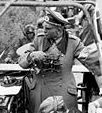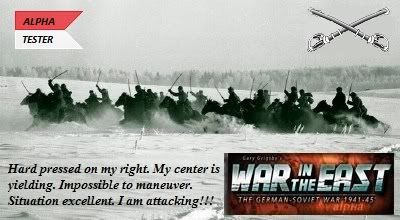Scarz
Posts: 325
Joined: 12/20/2010
From: Dallas Texas
Status: offline

|
I hate to jump into this discussion as it looks like its mostly for those playing the axis. I am the opponent IdahoNYer is playing in the campaign game with all the forts.
I agree that some of the fortifications seem to be a bit much. It might help if the game gave an explanation as to what the levels approximated, ie is level one simple fighting positions that can be dug in a night of hard digging, and is level 2 the same fighting positions with good overhead cover and some wire and mines and nicely drawn fire plans etc? I would think that in six months some pretty hefty positions could be dug, especially with lots of engineers.
Here is an example of what the Leningrad defenses were composed of that I pulled off the net.
"On June 27, 1941 the Council of deputies of the working people of Leningrad decided to mobilize thousands of people for the construction of fortifications. Several defences were built. One of the fortifications ran from the mouth of the Luga River to Chudovo, Gatchina, Uritsk, Pulkovo and then through the Neva River. The other defence passed through Petergof to Gatchina, Pulkovo, Kolpino and Koltushy. Another defense against the Finns was built in the northern suburbs of Leningrad. In all, 190 km of timber blockages, 635 km of wire entanglements, 700 km of anti-tank ditches, 5,000 earth-and-timber emplacements and ferro-concrete weapon emplacements and 25,000 km of open trenches were built by civilians. Even the gun of the cruiser Aurora was mounted on the Pulkovskiye Heights to the south of Leningrad. However, when Soviet troops of the North-Western Front in the end of June were defeated in the Baltic Soviet Republics, the Wehrmacht had forced its way to Ostrov and Pskov. On July 10 both cities were captured and the Germans reached Kunda and Kingisepp whereupon they advanced to Leningrad from Narva, the Luzhski region, and from the south-east and also to the north and south of the Lake Ilmen in order to isolate Leningrad from the east and to join the Finns at the eastern bank of Lake Ladoga."
All that was done in what two months? What would it look like in six months of uninterrupted digging?
However, the Russian troops are so brittle, too brittle in my opinion in 41 and 42, that without these entrenchments, its just too easy for the axis. Unless the supply can be restructured in 42 to prevent the Germans from having the ability to attack virtually everywhere and with HQ build up, and if the Russians are not beefed up a bit the Germans are too powerful in 42.
So I am not sure we are really arguing, or debating, what the fortifications should look like, or how quickly they should be built. What the debate is really about, is how tough the Russians should be in 42, and how can the game be structured to allow for historical gains by the Germans in 42. Of course this should be relative. Some games, where the Russians did extremely well in 41, and saved much of their army and factories, the Russians should be tougher come 42. In games where the Germans made big gains, Russian losses were exceedingly high, like in my game, the Germans should have an easier time of it in 42.
In the end, in my humble opinion, while we want the game to follow the historical possibilities, we shouldn't force it to follow the same path as in the history books. Could the Germans have been stopped in 42 short of Stalingrad? Maybe, but probably not. Likewise, could the Germans have launched attacks both in the south towards Stalingrad and the Caucasus and made an attack against Moscow? Maybe, but the supply situation would probably have prevented such an ambitious undertaking.
As far as the fun of the game, I think everyone would like to see a fluid 42. If that's the case, make the entrenchments lower, and harder to get, but bump the Russians strength, so its not a walk in the park for the Germans, and so that they will have to choose a focus rather than attack everywhere as in June 41.
Scar
|
 Printable Version
Printable Version
















 New Messages
New Messages No New Messages
No New Messages Hot Topic w/ New Messages
Hot Topic w/ New Messages Hot Topic w/o New Messages
Hot Topic w/o New Messages Locked w/ New Messages
Locked w/ New Messages Locked w/o New Messages
Locked w/o New Messages Post New Thread
Post New Thread